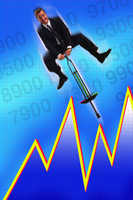| Home | About | Archives | RSS Feed |

@theMarket: The Trend Remains Your Friend
 |
The markets have weathered the recent storm of selling and have sprung back fairly quickly this week. There may still be a squall or two ahead, but it appears the worst is over for now.
We still have not tested my target of 1,709, the 200-day moving average (DMA) on the S&P 500 Index, but we were close. We fell to 1,739 intraday on that average, which was just 1.7 percent shy of my target. That's close but no cigar for me. Still, from the peak of the market to this week's low, the S&P 500 declined 6 percent. That was a reasonable decline.
It was enough to reduce the overbought conditions of the market and to reduce the overwhelmingly bullish sentiment of investors that had kept me cautious for most of the first month of the year. The question that remains is whether the markets have a larger drop in store for us sometime in the future.
In the meantime, I suspect we are on our way back to the highs, around 1,850 on the S&P 500. Once the averages regain those levels, we may climb even higher. Exactly how we get there will be important.
If the rally is fast and furious, while investor sentiment becomes increasingly complacent, then once again that exuberance will set us up for another implosion. The next time around, however, the pullback could be in the double digit range. So what will I be looking for in gauging the future risk of a sharp downturn?
I want to see a broad-based rally; one with increasing volume with all sectors performing well. On the other hand, a rising market, where advancers have a hard time outnumbering declines, and where valuations remain stretched with fewer and fewer stocks participating will turn me cautious once again. Under those conditions, I would expect renewed weakness and a deteriorating technical picture of the markets.
However, those are future concerns, which could or could not develop in the months ahead. For right now, the pullback is essentially over. What lessons readers should take away from this experience are two-fold. Number one, the markets will have these kind of sell-offs 3 or 4 times a year. Although it is easier to spot a potential short-term decline, it is practically impossible to call a short-term bottom. That's why I advised you to do nothing.
Number two, attempting to avoid these sell offs by trading out and then buying back into the market is extremely difficult, if not impossible, on a consistent basis. Let's say you did not follow my advice, but instead sold out a few weeks ago when I first advised readers that a pull back was in the offing. So far, so good. Congratulations, you saved some money but when do you get back in?
My target for a potential bottom was the 200 DMA on the S&P 500 Index, which we never reached. Remember this forecasting stuff is an art, not a science. Instead, it was the Dow Jones Industrial Average that hit and broke its 200 DMA on Monday into Tuesday and then bounced. The rest of the indexes took heart and followed the Dow higher.
No harm done for those who took my advice and stayed fully invested. Your paper losses are rapidly dwindling as the markets gain traction. But for those short-term traders who are still waiting for the S&P to breach its 200 DMA, well, that's my point.
Do you hope the markets' bounce will fail and go lower from here, what if it doesn't?
Will you be forced to chase stocks higher? As I've said, getting back in is a lot more difficult than you may think. While you ponder your next move, the rest of us can be grateful that this correction is over.
Bill Schmick is registered as an investment adviser representative with Berkshire Money Management. Bill’s forecasts and opinions are purely his own. None of the information presented here should be construed as an endorsement of BMM or a solicitation to become a client of BMM. Direct inquires to Bill at 1-888-232-6072 (toll free) or email him at Bill@afewdollarsmore.com.
@theMarket: It's Not 2008
 |
This week the markets lost some ground. In the scheme of things, it wasn't much, less than 3 percent on the S&P 500 Index. By the number of concerned calls I received, you would think we were back in the financial crisis. Investors need to chill out.
Let's look at things with a longer perspective than just the first three weeks of January. In the fourth quarter of 2013, the S&P was up 12 percent. For the year, it was up almost 30 percent and the other averages did as well and some did better. A 10 percent decline after a runup like that would not be out of the ordinary. I have been expecting a pullback to at least the 50-day moving average, which is around 1,800 and possibly below that.
Readers, we need some sort of consolidation and selling is a perfectly normal and predictable event in the historical life of the stock market. The alternative would be a market that continues to go up, up and away until it was so extended it snapped like a rubber band. It would only end in disaster and a 20-30 percent collapse in prices. You don’t want that and neither do I.
At the same time, over in the bond market, you may have noticed that interest rates have taken a breather on their march higher, while gold, which has experienced a 50 percent retracement over the last year, seems to be gaining ground. That is as it should be.
Nothing goes straight up or straight down. The 10-Year U.S. Treasury note in the space of less than eight months has seen its rate rise from 1.67 percent to a high of over 3 percent. It is presently hovering around 2.73 percent. It could easily trade in a range of 2.50 percent to 2.75 percent for several months as it consolidates.
Gold, on the other hand, has also had a very bad year and a bounce back of $200/ounce or more would be entirely normal. Make no mistake: both gold and bonds have entered a bear market that will last several years while the stock market, in my opinion, has entered a multi-year bull market. But nothing goes straight down or up.
I do recognize that many investors have had a hard time moving beyond the losses they sustained during the financial crisis and subsequent stock market meltdown. No one wants to see that happen again. Yet, I believe that was a once in a generation occurrence. It is over four years since those events occurred; the time has come to get beyond it.
If you are still so traumatized that every down draft in the market keeps you up at night reliving the past, then you should not be invested in stocks or bonds, commodities or anything but cash for that matter. Every investment holds risk (and reward). There is no such thing as a free ride where you can earn a good return on your money without risking some loss.
My bet is the market will likely bounce off these levels, if not a bit lower, make a lower high and then come down to a level below where we are today. It's the cost of doing business in the stock market. Over the course of the next several months any losses will be made up, so I'm content to lick my wounds, take a few paper losses and allow the markets to go through this healthy consolidation period. You should do the same.
Bill Schmick is registered as an investment adviser representative with Berkshire Money Management. Bill’s forecasts and opinions are purely his own. None of the information presented here should be construed as an endorsement of BMM or a solicitation to become a client of BMM. Direct inquires to Bill at 1-888-232-6072 (toll free) or email him at Bill@afewdollarsmore.com.
@theMarket: A Cause to Pause
 |
Markets usually need something to move them. Good news or bad, the markets want an excuse to go up or down. Now that the government, the debt ceiling, the budget and the Fed are temporarily out of the picture, investors are finally focusing on something meaningful — earnings.
Actually, that is a good thing. It may indicate that the financial sector is at last returning to its historical roots after years of government bail-outs, monetary control and political drama. There was a time, some of you may remember, when earnings could make or break the markets. I don't think we are there yet, but company earnings this week have given the market cause to pause.
The sampling of company data thus far in this earnings season has been lackluster at best. Companies in the financial, health care, retail and several other sectors have disappointed. The Christmas season, for example, was evidently a disappointment for many traditional, non-internet retailers. Consumer shopping behavior is clearly changing as more and more people shop the web and shun the malls.
To tell you the truth, I am one of those who have abandoned the store for the ease, convenience and competitive prices offered through my computer. Just about all of my holiday shopping was done that way, including the gift certificate I purchased for my wife at a local clothing store.
In the financial sector, banks and brokers are struggling with the new curbs on proprietary trading as well as regulations that require them to amass more capital to offset the risks they are taking in their businesses. Bond trading, which had been a big profit center for financial institutions, also did poorly thanks to rising interest rates.
Granted, it is still early days in the earnings season. I am sure that there will be some absolute gems in upside earnings surprises. The trick is to identify those companies that shine and avoid those that won't. Wow! Could we really be at that point in the recovery where the fundamentals of individual companies have once again become important to their stock price?
As readers are aware, I believe the economy is accelerating and employment rising. All is well in the world right now. Markets over the last few years have climbed a wall of worry but it appears that those worries have faded. We have yet to replace them with new ones or maybe the new worry is that there isn’t anything to worry about it?
So what are the negatives?
We are in the second year of a four-year presidential cycle. If one looks back through the post-World War II period, we find that these "second years" have been the absolute worst performance years in the stock market. To make matters worse, stock market returns have been even lower than normal when the president has been a Democrat.
Valuation also bears watching. Markets are not yet expensive, but could become so if enough companies fail to live up to expectations. What is now simply a pause in the market's advance could become a rout, if too many companies disappoint. But what continues to bother me the most is the sentiment indicators. There are just too many bulls out there for my taste. As a contrarian, I like the markets most when no one else does. However, none of the potential negatives tempt me to bail on stocks. Stay the course.
Bill Schmick is registered as an investment adviser representative with Berkshire Money Management. Bill’s forecasts and opinions are purely his own. None of the information presented here should be construed as an endorsement of BMM or a solicitation to become a client of BMM. Direct inquires to Bill at 1-888-232-6072 (toll free) or email him at Bill@afewdollarsmore.com.
@theMarket: Statistically Speaking
 |
Wall Street is awash with statistics on any given day. Some are useful while others simply add to the level of noise, but on occasion we do get some hints of where the markets are going by looking at past data.
Take the month of January for example, historically it has been a good month for stocks.
It is a time when new money supposedly floods into the stock market, pushing the averages up. That gets investors excited. They begin to anticipate a big up year. Some say that if the Dow Jones Industrial Average is higher after the first five days in January, then the month will be positive. Others argue that if the month finishes on an up note so will the year.
The S&P 500 Index has been up 13 of the last 20 Januarys, so statistically the odds are in our favor but not by that much. What may add weight to those probabilities is the market's performance in 2013. The S&P 500 Index was up 30 percent last year (not counting dividends).
Whenever that has occurred in the past (75 percent of the time since 1928), the next year's January gained on average 2.4 percent. There have been four years since 1995 that the S&P 500 closed with over 20 percent gains and all four years saw average gains of 2.5 percent.
As for the market's predicted performance in 2014, there is more good news ahead thanks to the gains of last year. Since 1950, there have been 17 instances when the S&P 500 was up more than 20 percent in a year. The same index finished positive the following year 14 times (82 percent probability). There have been four years since 1995 that the S&P 500 closed with over 20 percent gains and in all four years the average gain was 2.5 percent.
There is little to worry about on the domestic or on the global front right now.
Washington politicians are playing nice for now. This year's elections will short circuit any tendencies by the tea party to create another crisis in the first quarter. The economic numbers in the U.S., Europe and Japan are encouraging. Those are the three markets that investors should be focused on. Europe is lagging our own recovery by a year or two. Japan represents enormous upside in the years ahead and we here at home have entered a secular bull market.
So far the jury is out on January. Thursday was a down day and Friday we recouped some of those losses. I am betting that next week sees some further upside. However, somewhere out there a pullback is lurking. I expected it to happen in December but at its worst, the market was down less than 2 percent.
Interest rates continue to rise with the 10-year U.S. Treasury now over 3 percent. I believe rates are heading much higher. Part of the reason that the stock market continues to gain is that bond holders are finally getting religion. They are selling bonds and buying back into equities.
It is too hard to call the movements of the market in the short term but history seems to indicate that we should expect to see a few more days, if not weeks, of gains before this rally comes to a close. In any case, my advice remains the same for readers — stay invested.
Bill Schmick is registered as an investment adviser representative with Berkshire Money Management. Bill’s forecasts and opinions are purely his own. None of the information presented here should be construed as an endorsement of BMM or a solicitation to become a client of BMM. Direct inquires to Bill at 1-888-232-6072 (toll free) or email him at Bill@afewdollarsmore.com.
@theMarket: From One Fed to Another
 |
What a week it was! The U.S. central bank marked the end of its quantitative easing, while promising to keep interest rates low. On the other side of the world, the Japanese central bank did the opposite. Its Fed increased the amount of stimulus it will add to the economy from $600 billion to more than $730 billion per year.
Oh, and by the way, the U.S. stock market loved the news. The S&P 500 Index climbed to within a hair's-breadth of its historical high while the Dow actually made a new intra-day record. It is good news if you are a global investor, which I am. More stimuli, wherever it may be, actually enhances global growth and that's good for us. Despite those who criticize the Federal Reserve's quantitative easing efforts since 2009, these actions have not only carried this economy back from the brink but set it up for further growth in the future while sending our stock markets to record highs.
That has not happened elsewhere because central banks worldwide have failed to emulate the Fed's actions. Europe, as I have often said, is struggling because their central bank cannot develop consensus among its EU members to do what it takes to put Europe back on firm footing. Japan, on the other hand, is a horse of a different color.
They have taken the U.S. Fed's playbook and ran with it. Their first QE project, announced almost two years ago, began the herculean effort of pulling that island nation from a 20-year economic funk of no growth and deflation. That was a good start, but similar to our own QE I, it's not enough to do the job. Yesterday, their central bank announced further stimulus, call it QE II, which vaulted the Nikkei stock market over 5 percent on the news.
If you have been reading my columns over the years, you know that I first recommended Japan as a long-term buy back when the Fukushima Crisis had devastated the country ("Japan: The Sun Is Beginning to Rise" June 2, 2011). At that time, the Nikkei was at 9,955. The Nikkei now stands at 16,413. Investors who followed my advice have made about 65 percent on their investment. So what's next?
Japan's stock market should continue to climb. My mid-term target for the TOPIX, which is the Tokyo Stock Exchange's price index, is1,750 which is a 26 percent gain from its present level. That's not too shabby, but don't neglect the U.S. market either. After sounding the "all clear" in my last column, U.S. markets have continued to climb. I expect those gains to continue through the end of the year and into next year. Why?
The economy is growing. I believe that growth will surprise you on the upside as events unfold. Although we still need to do more work on the labor side, especially in seeing more full-time jobs and pay increase, consumer spending is starting to come around. The fact that energy prices have dropped precipitously will help out on the spending end as well as in the months to come.
If I am right, after mid-term elections, we may finally see those do-nothings in Congress actually get to work on a new economic stimulus plan. Call me a cock-eyed optimist, but I am actually hoping for compromise legislation out of both parties. All-in-all, the picture I see unfolding in the months ahead is quite positive. Have a Happy Halloween.
Bill Schmick is registered as an investment adviser representative with Berkshire Money Management. Bill’s forecasts and opinions are purely his own. None of the information presented here should be construed as an endorsement of BMM or a solicitation to become a client of BMM. Direct inquires to Bill at 1-888-232-6072 (toll free) or email him at Bill@afewdollarsmore.com.

